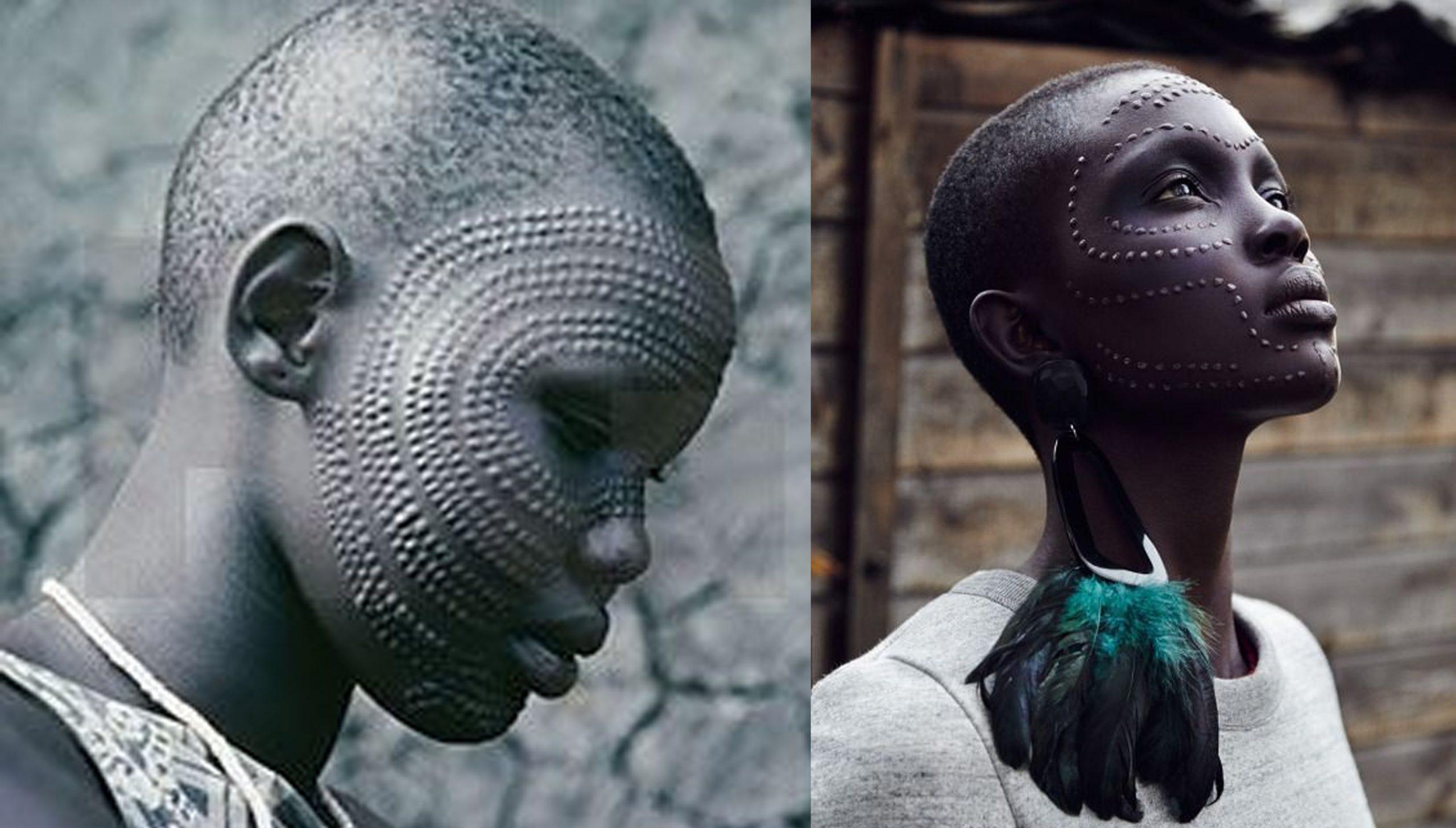Scarification has played an essential role in the culture of various communities in Africa. Scarification is the process of creating meaningful pictures, words, or designs on the skin by making superficial wounds with stones, glass, knives, or other objects. This long-term physical change can convey a wide range of cultural messages.
Scarification is used to show clan identity, status within a community, passage into adulthood, or spiritual significance in cultures ranging from Ethiopia to Papua New Guinea. Scars of various sizes, shapes, and positions are used to show clan identity, status within a community, passage into adulthood, or spiritual significance.
Scarification is a permanent body modification or body art that involves scratching, etching, burning / branding, or superficially cutting designs, photos, or words into the skin. It can take 6–12 months for the bodily change to heal. Scars are created by cutting or branding the skin in various ways throughout the body scarification process (sometimes using further sequential aggravating wound-healing methods at timed intervals, like irritation).
Traditional Practitioners
Scarification has been used by darker colored societies for centuries, probably because it is more apparent than tattoos on darker coloured people. The indigenous civilizations of Africa (particularly in the west), Melanesia, and Australia were all represented.
Among the ethnic groups in sub-Saharan Africa that traditionally practice scarification are the Gonja, Dagomba, Frafra, Mamprusi, Nanumba, Bali, Tɔfin, Bobo, Montol, Kofyar, Yoruba, and Tiv people of West Africa, and the Dinka, Nuer, Surma, Shilluk, Toposa, Moru, Bondei, Shambaa, Barabaig, and Maasai people of East Africa.
Reasons
The study of the body as a boundary has long been a point of contention in anthropology. [1] In 1909, Van Gennep defined rites of passage as body alterations such as tattooing, scarification, and painting.
Many West African tribes have utilized scarification to signify significant life events in both men and women’s lives, such as puberty and marriage. Members of various tribes who refused to participate in scarification were typically excluded from the group’s activities and outcast from society.
According to anthropologists, members of a group who lack the regular features of the group are not regarded fully developed as agents in their society; they also lack the potential for significant behavior such as greeting, commanding, and expressing.
As a result, scarification has the ability to change partial tribe members into “regular” members who are fully accepted by the group. Scarification is a type of language that isn’t easily stated, save through long and complicated greetings, and it allows people to communicate fully, which is a requirement for being accepted as a normal member of the group.
Scarification is viewed as proof of adulthood since it demonstrates the ability to bear pain. Young men, especially in communities where males have duties as hunters and warriors, demonstrate strength and discipline by enduring the pain of scars. A young man who has already felt torn or cut flesh is thought to be less likely to be afraid of a wild animal’s teeth or the tip of an enemy’s spear.
In Ethiopia and Zambia, complex scarification is commonly performed on young women to indicate a desire to become mothers. The markings demonstrate her ability to withstand the agony of childbirth as well as her emotional development.
Some of these rites of passage have spiritual or religious foundations, such as the scarification of young boys of the Chambri tribe of Papua New Guinea to mark their journey into manhood, a practice based on the belief that humans evolved from crocodiles.
Suri men scar their bodies to signify that they had murdered someone from an opposing tribe in Ethiopia; the Mursi scarify their bodies mostly for beauty purposes to attract the opposite gender and increase the physical experience of s*x.
Identity
Scarification can be used to send complicated messages about identity; permanent body markings can highlight set social, political, and religious functions. When voluntarily acquired, tattoos, scars, marks, and piercings are ways of displaying a person’s autobiography on the body’s surface to the world.
Scarification can also be used to help people transition from victim to survivor status. These people go through numerous types of ritual death and rebirth and use their skin to redefine their relationship with society.
Many persons with “markings” in some parts of Africa can be identified as belonging to a certain tribe or ethnic group. The Gonjas, Nanumbas, Dagombas, Frafras, and Mamprusis are some of the tribes in Northern Ghana who employ the markings.
Medicinal
Scars above the eyes are thought to improve eyesight, and scars on the temples are thought to ease headaches, according to the Nuba tribe of Sudan. Scarification is a traditional medicine technique used in various cultures to cure illness by inserting medicine (typically herbs or powdered root) under the skin to heal a variety of infections and illnesses such as Malaria.
Scarification in many forms is employed as a method. Scarification isn’t an exact procedure; variables including skin type, incision depth, and how the wound is managed as it heals all influence the outcome. It’s possible that an approach that works for one individual won’t work for another. Because scars tend to spread as they heal, outcome design is usually simplistic, with the nuances lost during the healing process.
Some common scarification techniques include:
Ink rubbing
A new cut is rubbed with tattoo ink (or a similar agent) to give color or visibility to the scar. As the cut heals, the majority of the ink remains in the skin. Before the use of needles to inject ink, this was how tattoos were done.
Skin removal/skinning
When compared to simple cutting, skin removal allows for greater markings. A hook is used to lift the skin, which is then removed with a razor blade. This procedure can take many hours, and it frequently requires the removal of scabs in order for the scars to be seen.
Packing
Massive hypertrophic scars emerge as the wound pushes out the inert substance that was injected into the wound during healing. To improve keloid formation, anti-inflammatory treatments can be used.
 The African History Truly African
The African History Truly African

